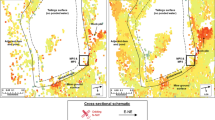Abstract
After the catastrophic failure of a red mud reservoir in Hungary, we performed a persistent scatterer radar interferometry (PSI) deformation analysis to investigate the stability and motion history of the entire area focusing on the dam walls of the collapsed structure. Our aim was to contribute to the better understanding of the disaster and, more importantly, to see whether it was possible to prognosticate and consequently prevent the failure of the reservoir and to help avoiding such occurrences worldwide. Our earlier data revealed that the surroundings were generally very stable over the investigated 8 years time interval, whereas significant continuous motions were detected on the embankments. After these first results, we continued our PSI deformation study with the processing and evaluation of the complete ascending pass ENVISAT dataset and later with the combination of the results of the two different observation geometries. From our descending and ascending data, it was possible to combine motions determined in line-of-sight directions and to investigate horizontal and vertical components allowing the estimation of ‘total’ velocity vectors, magnitude and directions, at those locations of the reservoir and on the entire study area where reflections from both projections were available. It was also possible to get information from several other segments of the embankments of the failed reservoir where the descending geometry was unfavorable. With the combination, the complete ENVISAT PSI analysis using both ascending and descending orbit data enabled us to constrain the role of the soil structure and to look at the differential uplift or subsidence due to swelling soil effect. It also enabled us to constrain the role of the deposited mud, slurry, and accumulated water, and the strength and design of the structure in the failure of the red mud reservoir. Models were also constructed to visualize the observed motions of the reservoir embankments and to highlight the location of strain and stress accumulation providing significant constraints on the natural and anthropogenic origin of the disaster.





Similar content being viewed by others

References
Bánvölgyi G (2010) Red mud storage dam failure in Hungary: the most serious accident of the Bayer process. Paper presented at XVIII international symposium ICSOBA-2010 Zhengzhou, China, 25–27 Nov 2010
Bus Z, Grenerczy G, Toth L, Monus P (2009) Active crustal deformation in two seismogenic zones of the Pannonian basin—GPS versus seismological observations. Tectonophysics 474:343–352
Ferretti A, Prati C, Rocca F (2001) Permanent scatterers in SAR interferometry. IEEE Trans Geosci Remote Sens 39(1):8–20
Ferretti A, Monti-Guarnieri A, Prati C, Rocca F (2007) InSAR principles: guidelines for SAR interferometry processing and interpretation (TM-19, February). ESA publications, Netherlands
Grenerczy Gy, Wegmüller U (2011) Persistent scatterer interferometry analysis of the embankment failure of a red mud reservoir using ENVISAT ASAR data. Nat Hazards 59(2):1047–1053. doi:10.1007/s11069-011-9816-6
Grenerczy G, Sella G, Stein S, Kenyeres A (2005) Tectonic implications of the GPS velocity field in the northern Adriatic region. Geophys Res Lett 32:L16311. doi:10.1029/2005GL022947
Tóth L, Mónus P, Zsíros T, Kiszely M, Czifra T (1996–2010) Hungarian earthquake bulletin. GeoRisk Geophysical Research and Consulting Ltd, Budapest. www.foldrenges.hu
Van der Kooij M, Hughes W, Sato S, Poncos V (2005) Coherent target monitoring at high spatial density: examples of validation results, Fringe Workshop, European Space Agency, 2005
Wegmüller U, Werner C, Strozzi T, Wiesmann A (2003) Multi-temporal interferometric point target analysis. In: Smits P, Bruzzone L (eds) Analysis of multi-temporal remote sensing images, Series in remote sensing, vol 3. World Scientific, Singapore (ISBN 981-238-915-61), pp 136–144
Zsíros T (2000) Seismicity and seismic hazard of the Carpathian basin: Hungarian earthquake catalogue (456–1995). HAS GGKI. (in Hungarian)
Acknowledgments
We are indebted to the European Space Agency for providing us the complete necessary dataset.
Author information
Authors and Affiliations
Corresponding author
Electronic supplementary material
Below is the link to the electronic supplementary material.
Rights and permissions
About this article
Cite this article
Grenerczy, G., Wegmüller, U. Deformation analysis of a burst red mud reservoir using combined descending and ascending pass ENVISAT ASAR data. Nat Hazards 65, 2205–2214 (2013). https://doi.org/10.1007/s11069-012-0470-4
Received:
Accepted:
Published:
Issue Date:
DOI: https://doi.org/10.1007/s11069-012-0470-4



